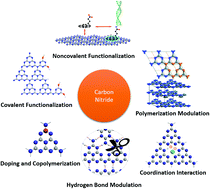当前位置:
X-MOL 学术
›
Chem. Soc. Rev.
›
论文详情
Our official English website, www.x-mol.net, welcomes your
feedback! (Note: you will need to create a separate account there.)
Molecular engineering of polymeric carbon nitride: advancing applications from photocatalysis to biosensing and more
Chemical Society Reviews ( IF 40.4 ) Pub Date : 2018-03-08 00:00:00 , DOI: 10.1039/c7cs00840f Zhixin Zhou 1, 2, 3, 4, 5 , Yuye Zhang 1, 2, 3, 4, 5 , Yanfei Shen 4, 6, 7, 8 , Songqin Liu 1, 2, 3, 4, 5 , Yuanjian Zhang 1, 2, 3, 4, 5
Chemical Society Reviews ( IF 40.4 ) Pub Date : 2018-03-08 00:00:00 , DOI: 10.1039/c7cs00840f Zhixin Zhou 1, 2, 3, 4, 5 , Yuye Zhang 1, 2, 3, 4, 5 , Yanfei Shen 4, 6, 7, 8 , Songqin Liu 1, 2, 3, 4, 5 , Yuanjian Zhang 1, 2, 3, 4, 5
Affiliation

|
As a promising two-dimensional (2D) conjugated polymer, polymeric carbon nitride (CN) is attracting dramatically increasing interest due to its unusual properties, facile synthesis from abundant and inexpensive starting materials, and promising applications ranging from (photo)catalysis, and photoelectrochemistry, to biosensors. The polymeric feature and facile synthesis of CN allow easy engineering of its structure at the molecular level. For instance, the moderate reactivity of CN at the interface, together with the aromatic π-conjugated framework and intralayer hydrogen bonds, provides ample possibilities to control its molecular structure and properties to meet task-specific applications. This review summarizes and highlights a panorama of the latest advancements related to the design and construction of the molecular structure of CN, such as by doping and copolymerization, engineering of the polymerization degree, coordination interaction, covalent and noncovalent functionalization, and modulation of intralayer hydrogen bonding. Beyond photocatalysis, the emerging applications of CN are also briefly discussed with a special emphasis on sensing, bioimaging and biotherapy, smart responsive systems and photoelectrochemical devices. This review ends with perspectives on the challenges and future prospects of molecular engineering of CN.
中文翻译:

聚合氮化碳的分子工程:从光催化到生物传感的先进应用
作为一种有前途的二维(2D)共轭聚合物,聚合碳氮化物(CN)由于其非同寻常的特性,从丰富而廉价的起始原料容易地合成以及在(光)催化和光电化学等方面的有前途的应用而引起了人们的极大关注。 ,生物传感器。CN的聚合特征和容易的合成允许在分子水平上容易地工程化其结构。例如,CN在界面的适度反应性,以及芳族π共轭骨架和层内氢键,为控制其分子结构和性质提供了充分的可能性,以满足特定任务的应用。这篇评论总结并重点介绍了与CN分子结构的设计和构建有关的最新进展的全景图,例如通过掺杂和共聚,聚合度的工程化,配位相互作用,共价和非共价官能化以及层内氢键的调节。除了光催化作用外,还简要讨论了CN的新兴应用,特别着重于传感,生物成像和生物疗法,智能响应系统和光电化学装置。这篇综述以对CN分子工程学的挑战和未来前景的观点作为结尾。智能响应系统和光电化学设备。这篇综述以对CN分子工程学的挑战和未来前景的观点作为结尾。智能响应系统和光电化学设备。这篇综述以对CN分子工程学的挑战和未来前景的观点作为结尾。
更新日期:2018-03-08
中文翻译:

聚合氮化碳的分子工程:从光催化到生物传感的先进应用
作为一种有前途的二维(2D)共轭聚合物,聚合碳氮化物(CN)由于其非同寻常的特性,从丰富而廉价的起始原料容易地合成以及在(光)催化和光电化学等方面的有前途的应用而引起了人们的极大关注。 ,生物传感器。CN的聚合特征和容易的合成允许在分子水平上容易地工程化其结构。例如,CN在界面的适度反应性,以及芳族π共轭骨架和层内氢键,为控制其分子结构和性质提供了充分的可能性,以满足特定任务的应用。这篇评论总结并重点介绍了与CN分子结构的设计和构建有关的最新进展的全景图,例如通过掺杂和共聚,聚合度的工程化,配位相互作用,共价和非共价官能化以及层内氢键的调节。除了光催化作用外,还简要讨论了CN的新兴应用,特别着重于传感,生物成像和生物疗法,智能响应系统和光电化学装置。这篇综述以对CN分子工程学的挑战和未来前景的观点作为结尾。智能响应系统和光电化学设备。这篇综述以对CN分子工程学的挑战和未来前景的观点作为结尾。智能响应系统和光电化学设备。这篇综述以对CN分子工程学的挑战和未来前景的观点作为结尾。











































 京公网安备 11010802027423号
京公网安备 11010802027423号